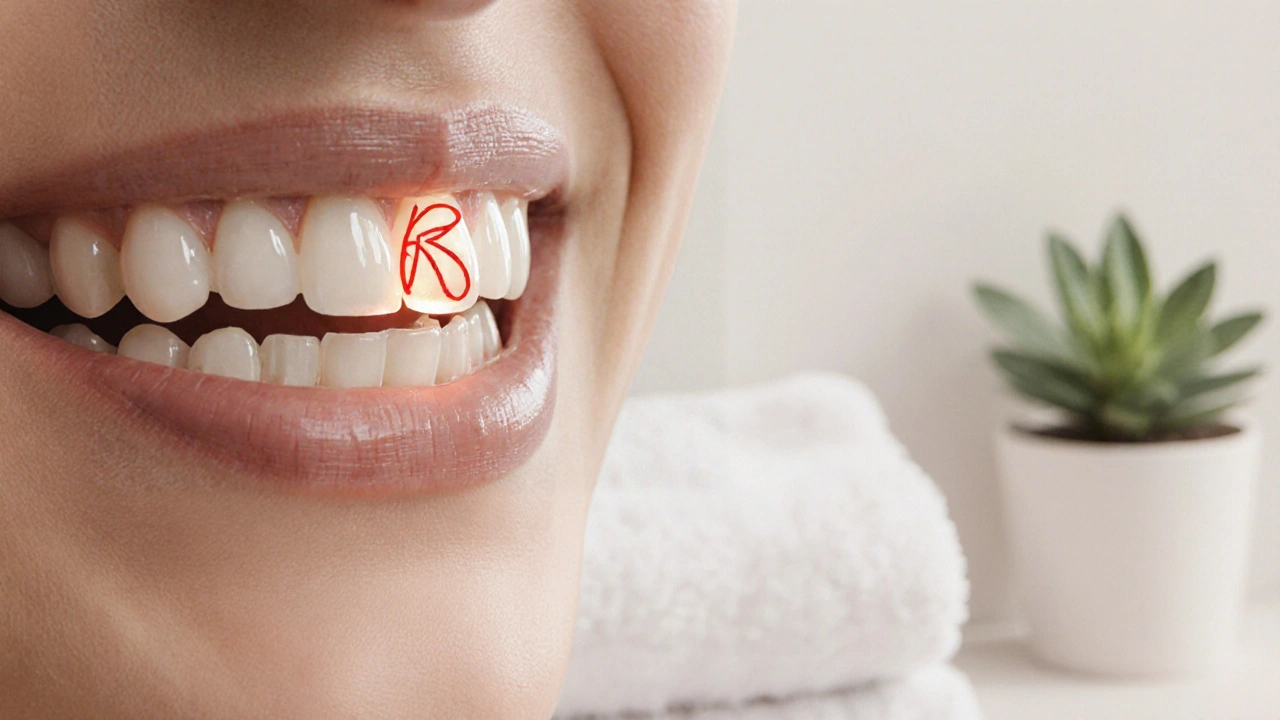When a sharp or throbbing pain shows up in your mouth, it’s not just an annoyance - it’s a signal from a complex biological system. Toothache is a type of oral pain that originates from the teeth, supporting structures, or surrounding nerves. Understanding why that pain fires up requires a quick tour of the tooth’s anatomy, the nerves that carry the message, and the microbes that love to set up shop.
Quick Take
- Tooth pain starts when dentin or pulp tissue is exposed to stimuli.
- Inflammation, bacterial infection, and nerve irritation are the main drivers.
- Look for signs of swelling, fever, or persistent throbbing - they often mean you need professional care.
- Good oral hygiene, reduced sugar, and regular dental check‑ups keep most pain at bay.
- Home remedies can soothe but never replace proper treatment.
What Is a Toothache?
At its core, a toothache is the brain’s interpretation of signals coming from the tooth’s inner layers. The outer shell, enamel, is the hardest tissue in the human body and protects the softer layers beneath. When enamel cracks or wears down, the underlying dentin - porous and rich in microscopic tubules - becomes exposed to temperature changes, pressure, and bacterial by‑products. Those tubules act like tiny highways, funneling sensations straight to the pulp, a soft core packed with blood vessels and nerves.
How Pain Signals Travel
The pulp houses the trigeminal nerve, the fifth cranial nerve responsible for facial sensation. When dentin tubules are stimulated, specialized receptors called nociceptors fire electrical impulses. Those impulses race along the trigeminal pathways to the brainstem, then up to the thalamus and finally to the cerebral cortex, where you consciously feel sharp or dull pain.
Main Culprits Behind Tooth Pain
Even though the nerve network is the final messenger, several upstream issues set the stage for pain:
- Dental caries (cavities) - Acid‑producing bacteria dissolve enamel, exposing dentin.
- Periodontal disease - Inflammation of gums and supporting bone can tug on the tooth’s root, irritating nerves.
- Cracked tooth syndrome - A hairline fracture lets fluid shift inside the tooth, shocking the nerves.
- Dental abscess - Pus‑filled pockets create pressure on the pulp.
- Sinus infection - The maxillary sinus sits just above upper molars; inflammation can be mistaken for tooth pain.
Each of these toothache causes triggers a cascade of inflammation that sensitizes the nerve endings, making ordinary sensations feel painful.
Inflammation & Infection: The Biological Trigger
When bacteria breach enamel, the immune system swings into action. White blood cells release cytokines - chemical messengers that cause swelling, redness, and heat. In the confined space of a tooth’s pulp chamber, even a modest amount of fluid buildup raises the internal pressure dramatically. This pressure compresses the nerves, lowering their pain threshold. The same process explains why a slight chip can feel excruciating if the pulp is already inflamed.

When a Toothache Means Emergency
Most tooth pains can wait a day or two for a dentist appointment, but some signs scream “urgent”:
- Sudden, severe throbbing that doesn’t fade.
- Visible swelling of the cheek, jaw, or gums.
- Fever, chills, or a metallic taste - signs the infection may be spreading.
- Difficulty opening the mouth (trismus) or swallowing.
- Pus draining from the gum line.
If any of these appear, schedule a dental emergency visit immediately. Delaying treatment can lead to bone loss, tooth loss, or even systemic infection.
Home Care While You Wait
While you arrange a professional appointment, a few simple steps can keep the pain manageable:
- Rinse with warm salt water (½ teaspoon salt in 8oz water) every 2‑3hours to reduce bacterial load.
- Take over‑the‑counter NSAIDs like ibuprofen (400mg) for up to 3days, unless contraindicated.
- Avoid extremely hot or cold foods - temperature swings aggravate dentin tubules.
- Apply a cold compress to the cheek for 15minutes, then remove for 15minutes.
- Do not place aspirin directly on the gum; it can burn tissue.
These measures soothe symptoms but don’t cure the underlying issue, so a dental visit remains essential.
Professional Treatments Explained
Once a dentist evaluates the problem, the treatment plan aligns with the specific toothache causes identified:
| Problem | Typical Symptoms | Standard Treatment |
|---|---|---|
| Dental caries | Localized pain, visible hole, sensitivity to sugar | Filling (composite or amalgam); deep decay may need a crown |
| Pulpitis (inflamed pulp) | Hot/cold sensitivity lasting minutes, spontaneous throbbing | Root canal therapy or pulpotomy, followed by restoration |
| Dental abscess | Swelling, fever, pus discharge, severe constant pain | Incision and drainage, antibiotics, and definitive root canal or extraction |
| Cracked tooth | Sharp pain on biting, release of pressure eases pain | Bonding, onlay, or crown; severe cracks may need extraction |
| Periodontal disease | Bleeding gums, recession, deep pocket pain | Deep cleaning (scaling & root planing), possible surgery, maintenance therapy |
In all cases, the goal is to eliminate infection, relieve pressure, and restore structural integrity.
Preventing Future Pain
Prevention isn’t a magic bullet, but a consistent routine slashes the odds of a painful surprise:
- Brush twice daily with fluoride toothpaste; fluoride strengthens enamel.
- Floss every night to remove plaque from between teeth - the hotbed of bacteria.
- Limit sugary snacks; bacteria thrive on leftover carbs.
- Visit the dentist for a check‑up and cleaning at least twice a year.
- Consider sealants on molars if you’re prone to cavities.
By keeping the enamel intact and the bacterial load low, you keep dentin and pulp out of the damage loop.
Frequently Asked Questions
Why does my tooth hurt more when I drink something cold?
Cold liquids trigger the fluid inside dentin tubules to contract, pulling on the nerve endings in the pulp. If enamel is worn or a cavity is present, the stimulus reaches the nerves directly, causing sharp pain.
Can a sinus infection really feel like a toothache?
Yes. The maxillary sinus sits just above the roots of the upper back teeth. Inflammation or pressure in the sinus can press on those roots, mimicking dental pain. Treating the sinus issue usually resolves the tooth‑like discomfort.
Is it safe to take ibuprofen for a toothache?
Ibuprofen is an anti‑inflammatory that can reduce both pain and swelling. For most healthy adults, 400mg every 6‑8hours is safe, but you should avoid it if you have stomach ulcers, kidney disease, or are on blood thinners without doctor approval.
What does a “pulpotomy” involve?
A pulpotomy removes the inflamed portion of the pulp while preserving the healthy tissue. The space is then filled with a medicated material and sealed with a crown. It’s often used on children’s baby teeth to maintain the tooth until it naturally falls out.
How long does a root canal take?
A typical root canal on a single tooth takes one to two appointments, each lasting about an hour. Complex cases or multiple canals may require more visits, but the procedure usually finishes within a week.


Rory Martin
September 28, 2025 AT 07:37It is imperative to recognize that dental pain is not merely a trivial inconvenience, but rather a manifestation of complex physiological processes. The enamel, while being the hardest tissue, serves as the primary barrier against environmental insults. Once this barrier is compromised, dentin becomes exposed, allowing external stimuli to reach the pulp. The pulp houses a dense network of nociceptive fibers that convey pain signals via the trigeminal nerve. These afferent pathways travel to the brainstem, thalamus, and finally the cortical regions where perception occurs. Inflammation within the pulp chamber elevates intrapulpal pressure, thereby lowering the threshold for nerve activation. Bacterial infiltration introduces endotoxins that exacerbate the immune response, resulting in cytokine release. Cytokines such as interleukin‑1 and tumor necrosis factor increase vascular permeability, leading to swelling. The confined space of the pulp means that even modest fluid accumulation can generate significant discomfort. Moreover, systemic factors such as fever or immunosuppression can amplify the local response. Clinical evidence suggests that timely intervention prevents the progression from reversible pulpitis to irreversible necrosis. Radiographic imaging often reveals periapical radiolucency when abscess formation has commenced. Antibiotic therapy alone is insufficient because it does not address the source of the infection within the dentin. Therefore, definitive treatment, whether it be a restoration, root canal, or extraction, is required to restore homeostasis. Preventive measures, including fluoride application and regular prophylactic cleanings, reduce the incidence of enamel demineralization. Finally, patients should be educated that self‑medication without professional assessment can mask symptoms while the underlying pathology advances.
Stacy McAlpine
October 14, 2025 AT 11:17Got it, Rory. I’ll add that flossing daily cuts plaque before it even gets a chance to attack enamel, which is a simple yet powerful habit.
Roger Perez
October 30, 2025 AT 13:57Wow, love how clear this breakdown is! 😃 It really helps to know why a cold drink feels like a punch in the teeth.
michael santoso
November 15, 2025 AT 17:37While the overview is adequate, it omits discussion of emerging photodynamic therapies that could revolutionize pulpitis management.
M2lifestyle Prem nagar
December 1, 2025 AT 21:17Brush twice a day.
Karen Ballard
December 18, 2025 AT 00:57Exactly, consistency beats occasional deep cleaning for long‑term oral health.